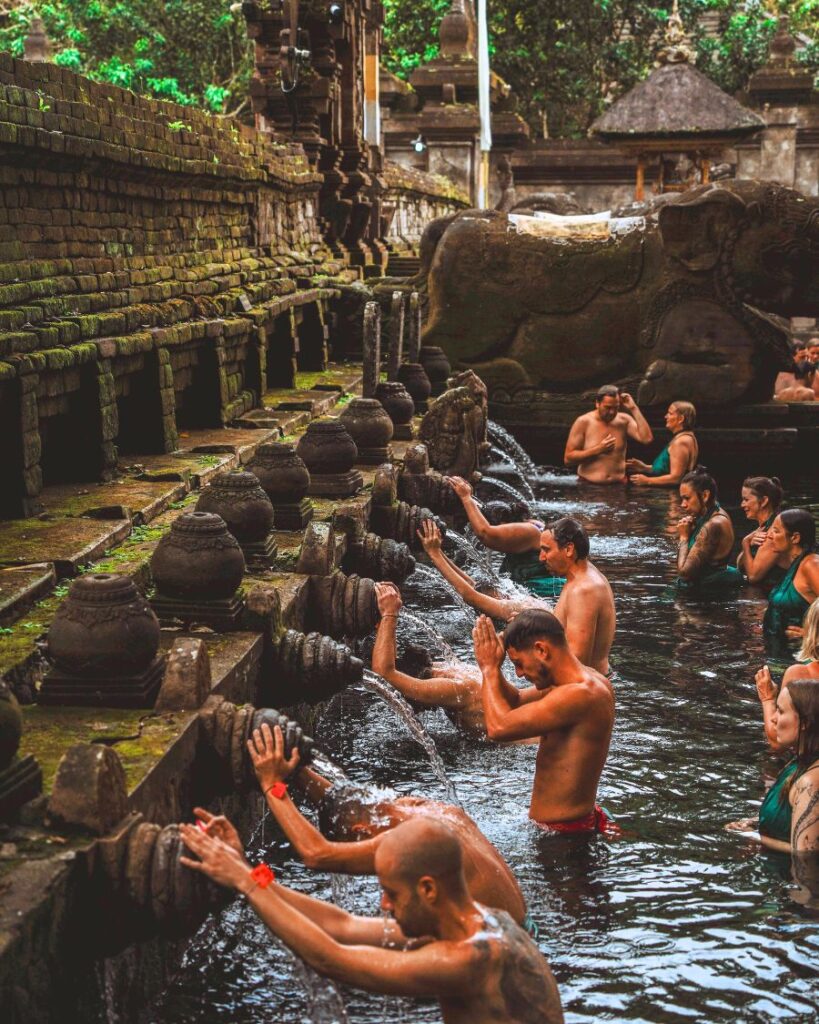
How to spend 3 days in Ubud, Bali? Every area of Bali has its own reputation and different reason to visit. Some areas have a party vibe, some are more laid back and beachy. Ubud is known for being the part where you go to to relax and experience Balinese culture. There are lush green rice terraces, stunning intricate temples, and of course – monkey forest! Read on for my recommendations on how to spend 3 days in Ubud, Bali.
Read: Stay at Arya Wellness Retreat in Ubud, Bali
Pura Tirta Empul Temple: Purification Ceremony
Pura Tirta Empul is a Hindu Balinese Water temple where visitors can take part in the Melukat spiritual cleansing ritual. Dating back to 962 AD, today Tirta Empul does feel more like a tourist attraction rather than a working temple. However, there is something special about people coming from all over the world to take part in a shared experience and celebrate Balinese culture. When you enter the temple complex you will be loaned a dry sarong. This adds to the exotic feeling as all the visitors wander around in colourful Balinese garb.
If you wish to participate in the Melukat water blessing, you can hire a green sarong for a small fee to wear in the water, tied with a red sash. Bring swimwear to put on underneath. You can pay for a locker to store your belongings. For a small donation you can also make an offering of petals and incense at the shrine. There are lots of local guides at the temple complex, and if you wish you can pay them to explain the correct instructions for the water ceremony and the significance of the various different fountains. I recommend doing this as some of the fountains should be skipped as they represent cremation. The guides also love taking photos and videos so absolutely worth it if you want memories of the experience, as you are not allowed to take cameras (go-pros and such) into the water itself.
Related post: Visiting Pura Tirta Empul Temple, Ubud, Bali.
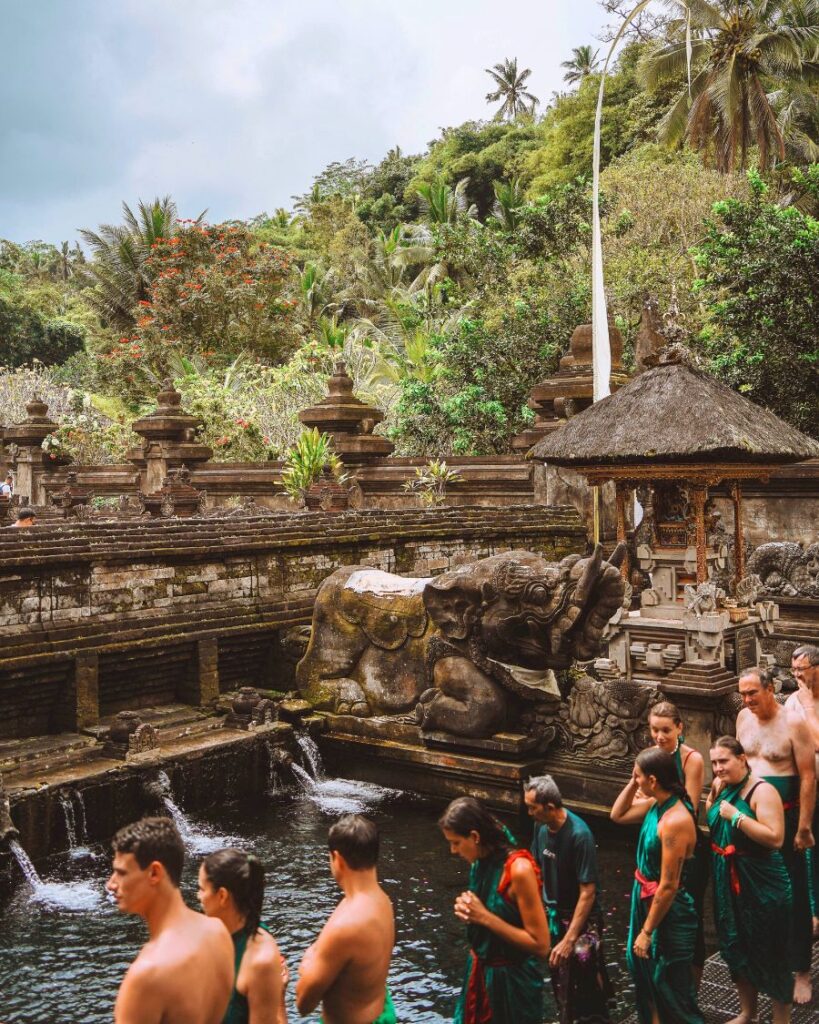
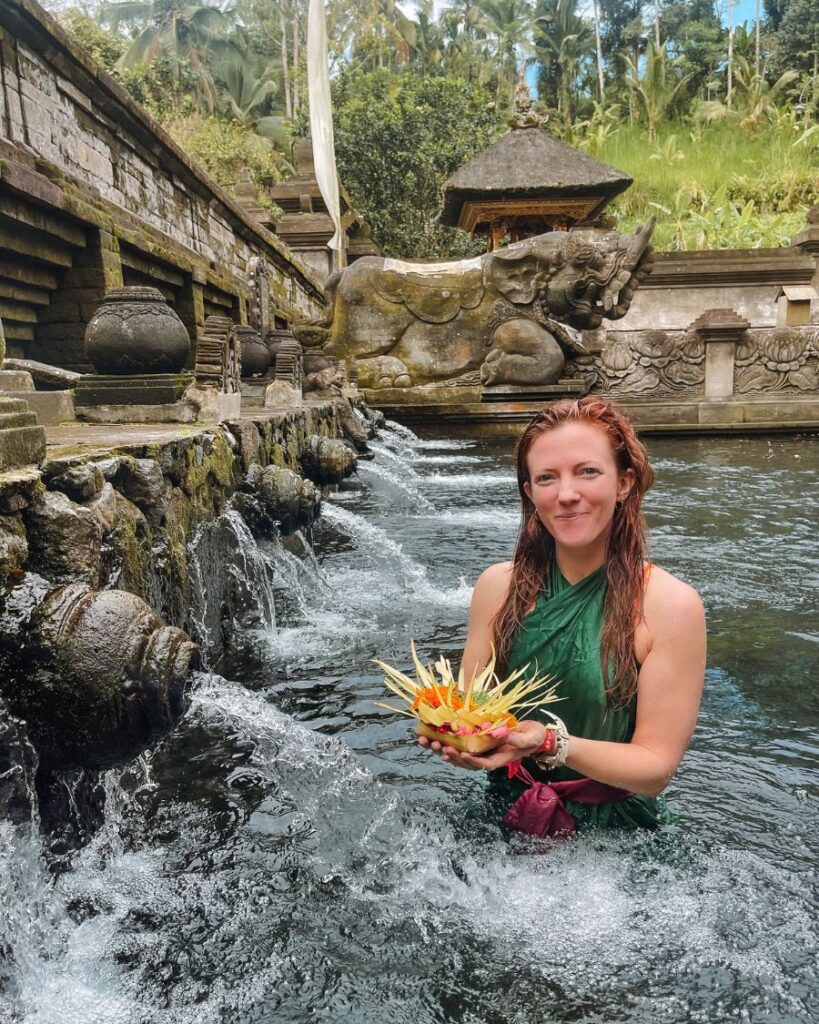
Monkey Forest
Ubud is famous for its cheeky local resident monkeys, and you can see them scampering around rooftops and on the powerlines. The Sacred Monkey Forest Sanctuary itself is right in the centre of Ubud and, as its name suggests, this is where most of the long-tailed macaque monkeys live. The site, dating back to the 14th century, was created according to the Hindu ideology of tri hita karana – harmony between god, people and nature. You need to pay an entrance fee to get in, but it’s worth it. The forest itself if beautiful, with three temples and old stone statues hidden amongst the trees. Make sure that you do not have any food or drink on you, as the monkeys are known for mugging people. They’ll also happily swipe anything shiny, so best to leave your sunnies and any valuables at home for this one.
From an ethical standpoint, the monkeys are wild and can come and go as they please. You must not feed the monkeys, as unsuitable food can be bad for them and lead to permanent health problems. If they are given human food they will develop a taste for this and will become a nuisance for local shops rather than foraging in the wild. Unfortunately I did see a lot of tourists behaving very badly and trying to touch a baby monkey. So although Monkey Forest does not seem fundamentally unethical, visitor behaviour is an issue. Related post: Is Monkey Forest in Ubud Ethical?
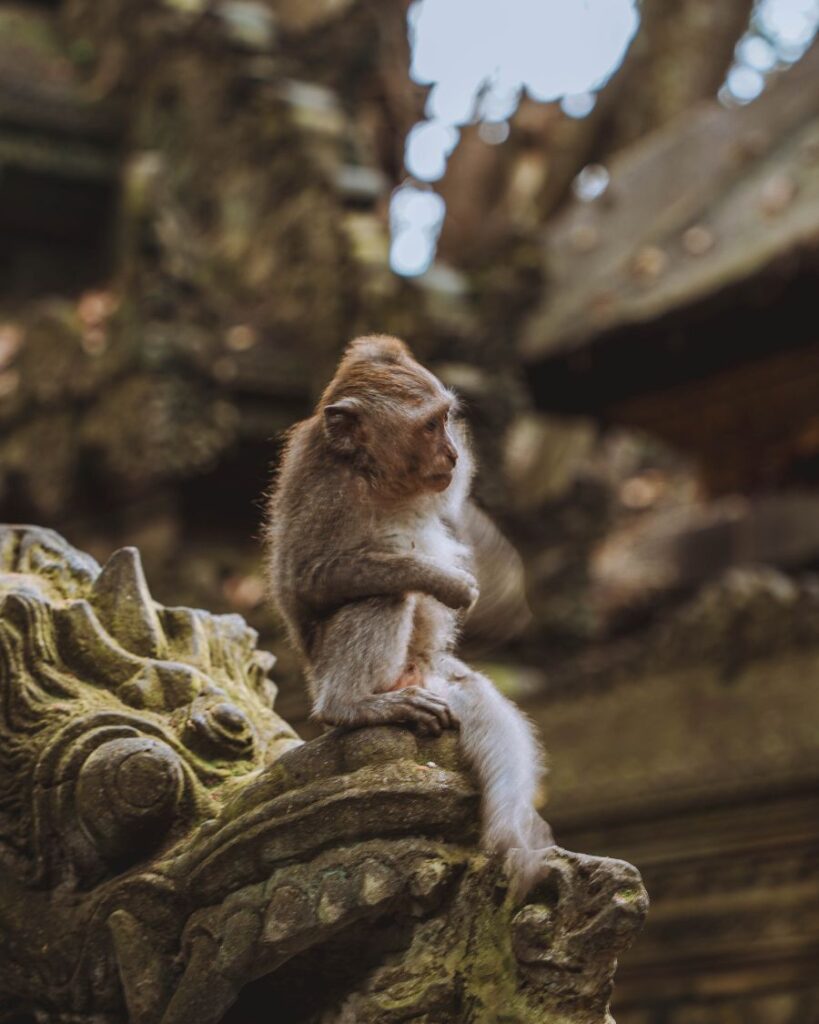
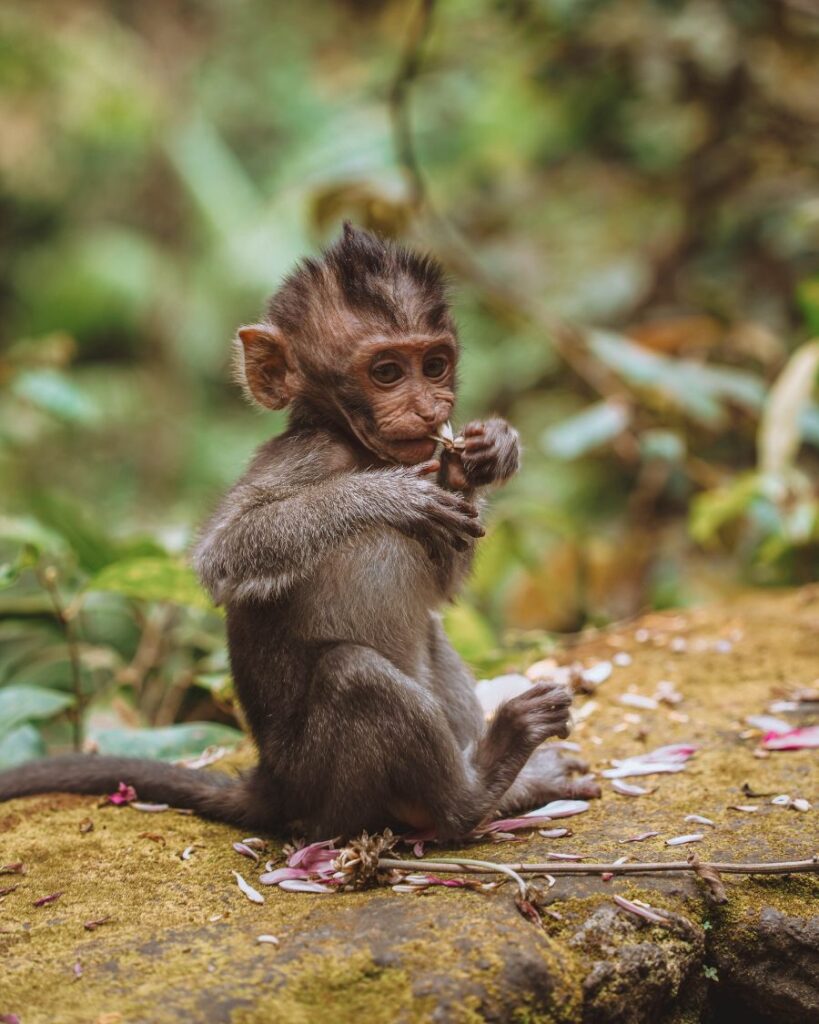
Ceking Tegallalang Rice Terraces and Bali Swing
Ubud’s rice terraces are an absolute must-do. It’s amusing and impressive that they have taken something as run-of-the-mill as rice farms and basically turned them into a Disneyland of sorts! Don’t let that put you off, the lush green rice terraces are absolutely beautiful and the atmosphere is fun in a relaxed way. If you do want to avoid the crowds there are plenty of smaller rice terraces all over Ubud. I visited the Ceking rice terraces at Tegallalang. Here you can find some of the famous Bali swings (there are several). You can hire a dress to wear as they swing you over the rice terraces. The staff really get into taking photos and videos too. It’s definitely one of the most ridiculous things I’ve done in my life but it was very fun!
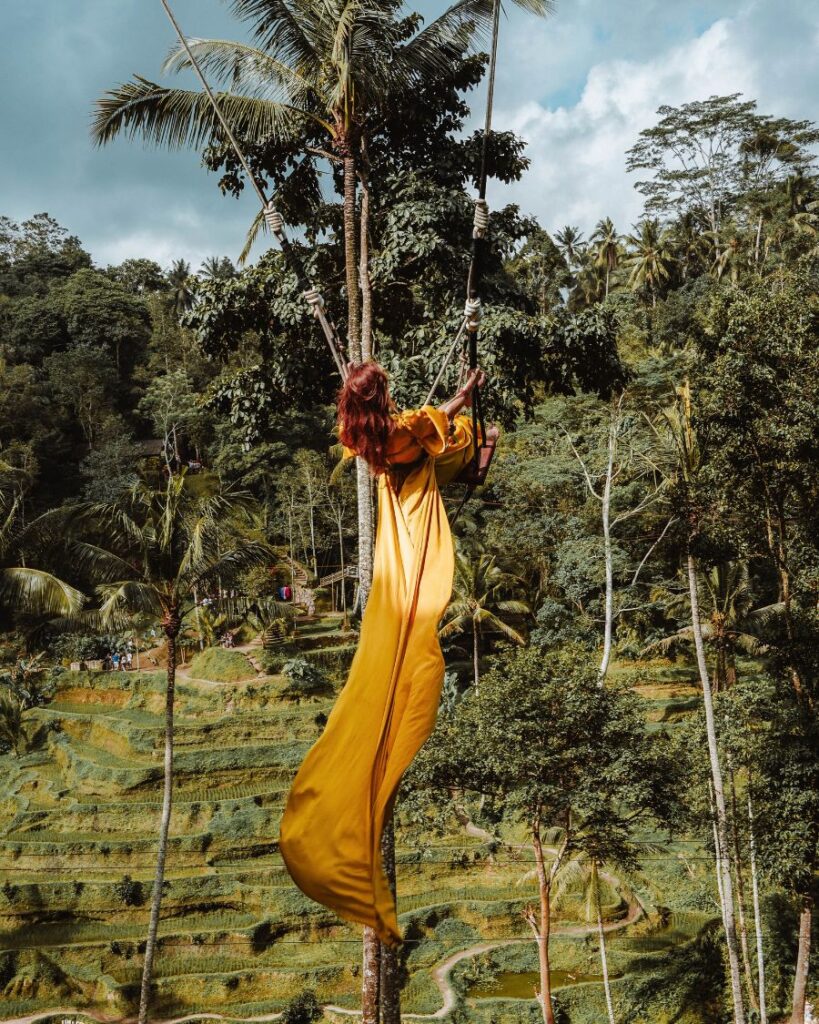
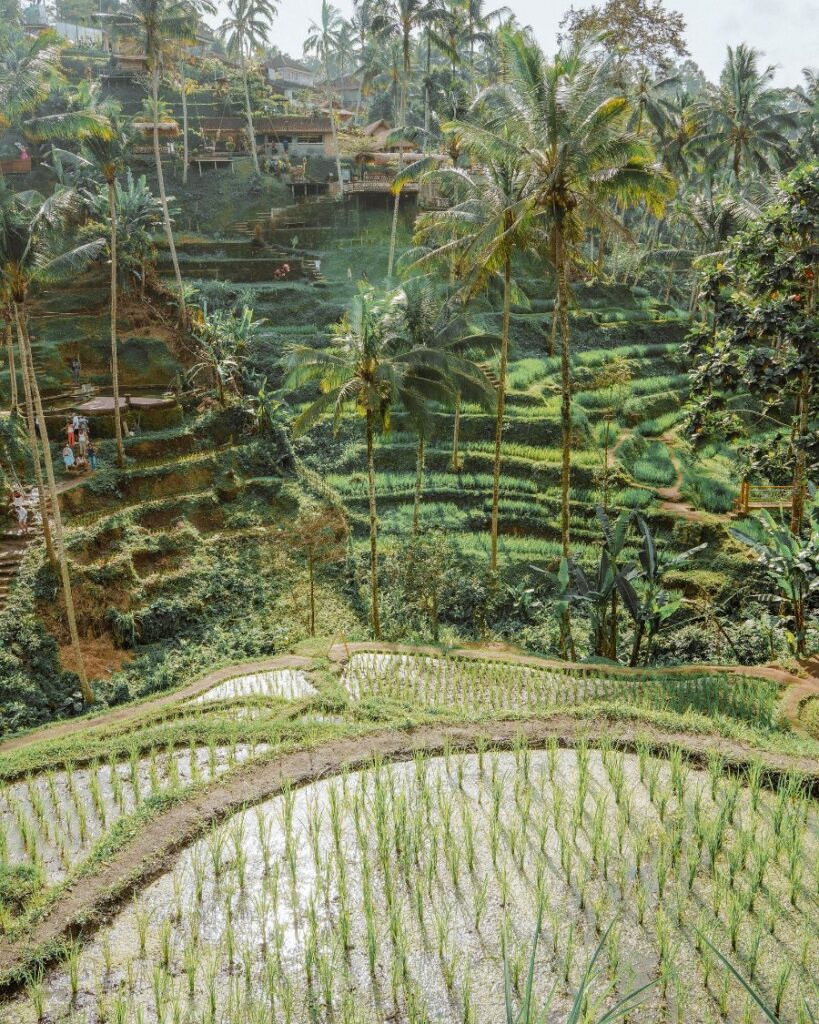
Relax at a Pool Bar
Next to the Tegallalang rice terraces there are a number of restaurants and bars that have swimming pools overlooking the rice fields. I had dinner at Tis Cafe and the views were spectacular.
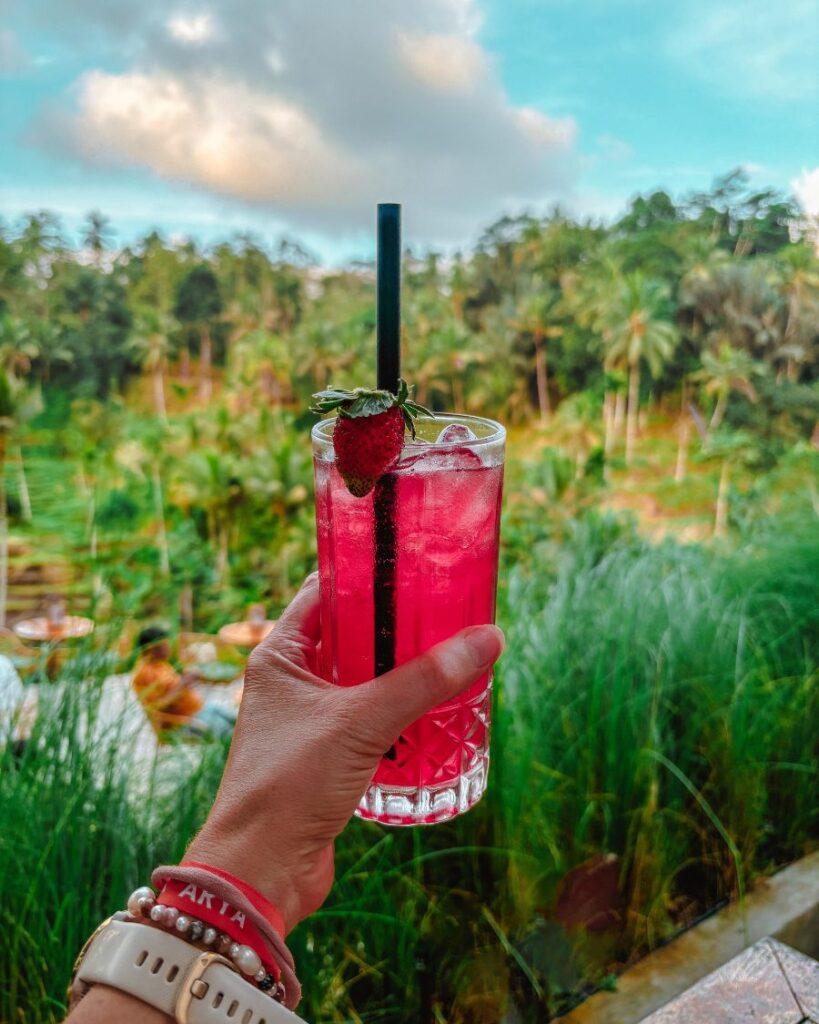
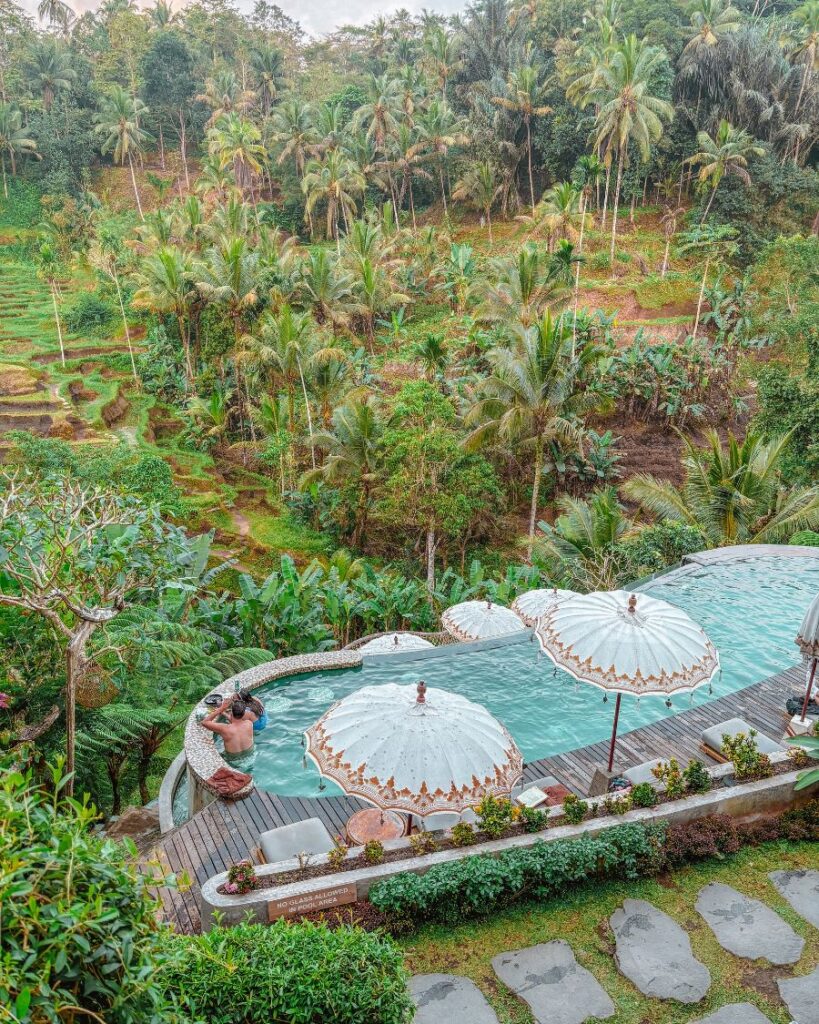
Campuhan Ridge Walk
Campuhan Ridge Walk is a beautiful walking track in the centre of Ubud, about 15 minutes walk from Monkey Forest. Best done either early in the morning or in the evening, the walk offers stunning views over the surrounding countryside. The trail is only 2 kilometers, but it’s not a loop track so you can just walk to the end and back again. Read my more detailed post on how to Hike the Campuhan Ridge Walk, Ubud, Bali.
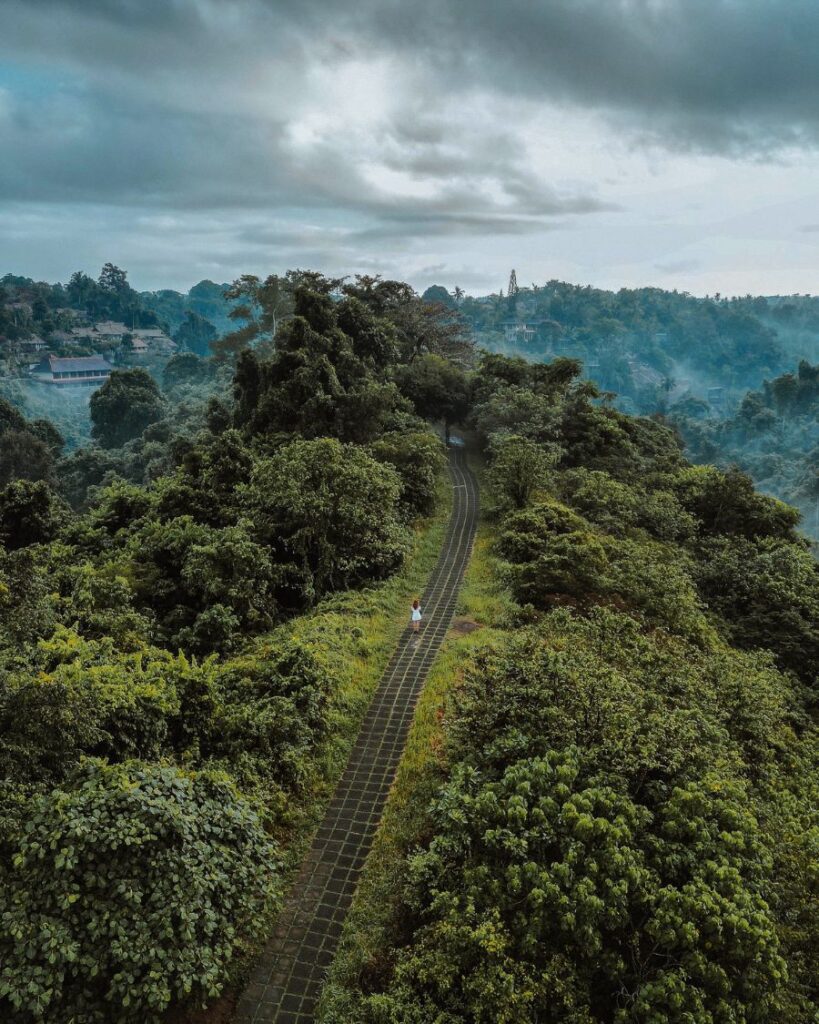
Sunrise Hike up Mount Batur
If you’re willing to get up exceptionally early (or just not go to bed!) you can join a sunrise hiking tour leaving Ubud at 2am! This allows you to ascend the sacred volcano Mount Batur before sunrise and watch the changing morning sky from the top. It is easiest to do this as part of a group tour. You can book in advance. The ascent takes around 2 hours on average.
Book: Sunrise Hike up Mount Batur
Practical Guidance for Bali, Indonesia
Hopefully this post will have inspired you to book a trip to Ubud, Bali. I’ve also included some useful information for Bali and Indonesia in general below. If you plan all the boring stuff in advance you can relax and enjoy your trip more!
How do I get a visa for Indonesia?
Make sure to check the Indonesian visa requirements for your own country as the rules can vary depending on what passport you have. Many countries can get a 30-day visa on arrival (VOA). I purchased mine at Bali Denpasar airport and was able to pay with my WISE card. You must meet passport validity requirements and have a return or onward ticket. You can explore different visa options on the official Indonesian Immigration website. If you overstay your visa there is a fine of 1 million rupiah a day.
Transport from Bali Denpasar airport to Ubud
Arriving at Bali Denpasar airport can be pretty hectic. It can feel overwhelming especially if you’ve just come off a long haul flight. A lot of flights seem to be scheduled to arrive quite late at night too, so I recommend planning in advance so that you feel safe. There will be a lot of local taxi drivers waiting at arrivals, but you will need to haggle which can be exhausting.
Personally, I booked an airport pickup in advance with Welcome Pickups. You prepay when you book at a flat rate that matches the local standard fare. The advantage of Welcome Pickups over rideshare apps (see below) is that there is no surge pricing. I did check my Grab app out of curiosity when I arrived to compare, and Welcome Pickups was indeed cheaper. The Welcome Pickups app is also incredibly easy to use and I was able to chat to my driver via the app to coordinate a meeting spot. Welcome Pickups operate in lots of different countries worldwide. You can sign up here.
How to get around Bali and Ubud
The easiest way to get around Ubud (and Bali in general) is to use Grab. Grab is a Singaporean-headquartered rideshare app (like Uber) that operates in a number of countries in South East Asia. You can choose to book either a car or a scooter. Scooters are cheaper and much faster as they can weave through the traffic. It’s also safer to use Grab and have a local driver rather than hiring a scooter yourself. I recommend downloading the app in advance before your trip so that you can set up the payment card etc. The best card to link in order to avoid high FX exchange fees is a WISE card (see below).
Money in Indonesia: (IDR)
If you’re visiting Indonesia you’ll need Indonesian Rupiah (IDR). To get IDR at the best rates, I highly recommend getting a WISE card before you go. This allows you to convert money into Indonesian Rupiah (or any other currency!) at the best rates and then spend on your Wise card as though it were a local bank card or withdraw cash in Indonesia without hidden fees. Wise is a UK-based financial services company (available in most countries worldwide) and is highly regulated in the various regions it operates in (in the UK it is authorised by the Financial Conduct Authority).
Get your WISE card here.
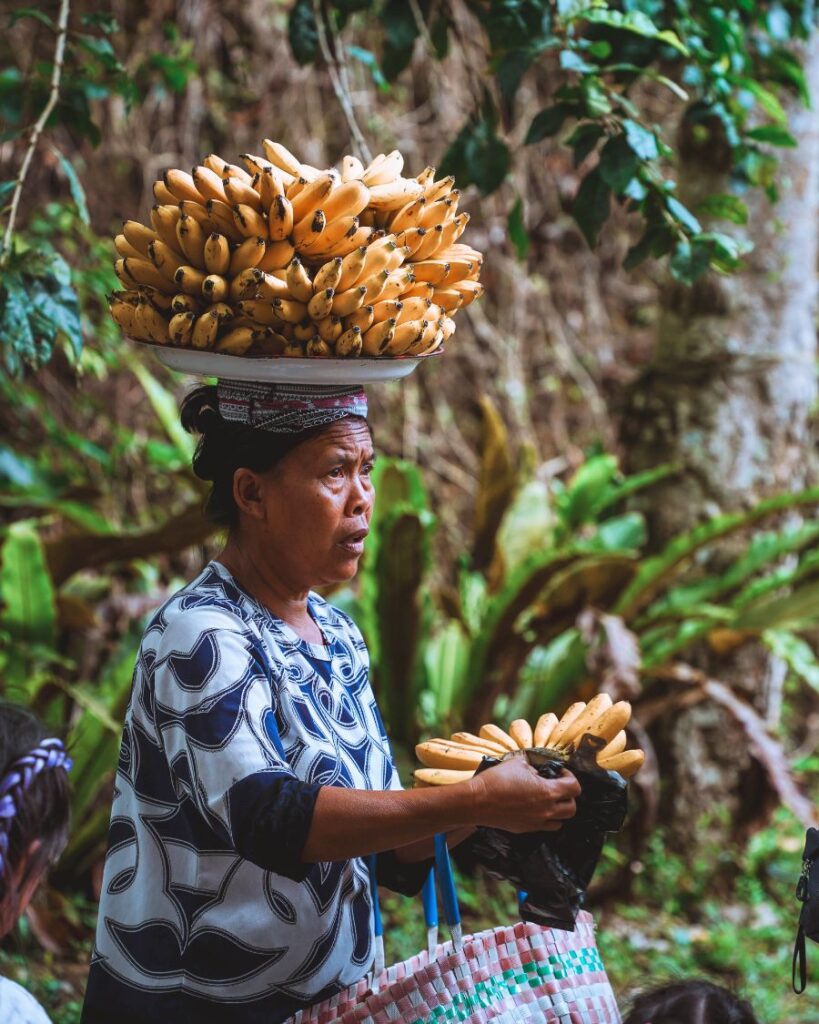
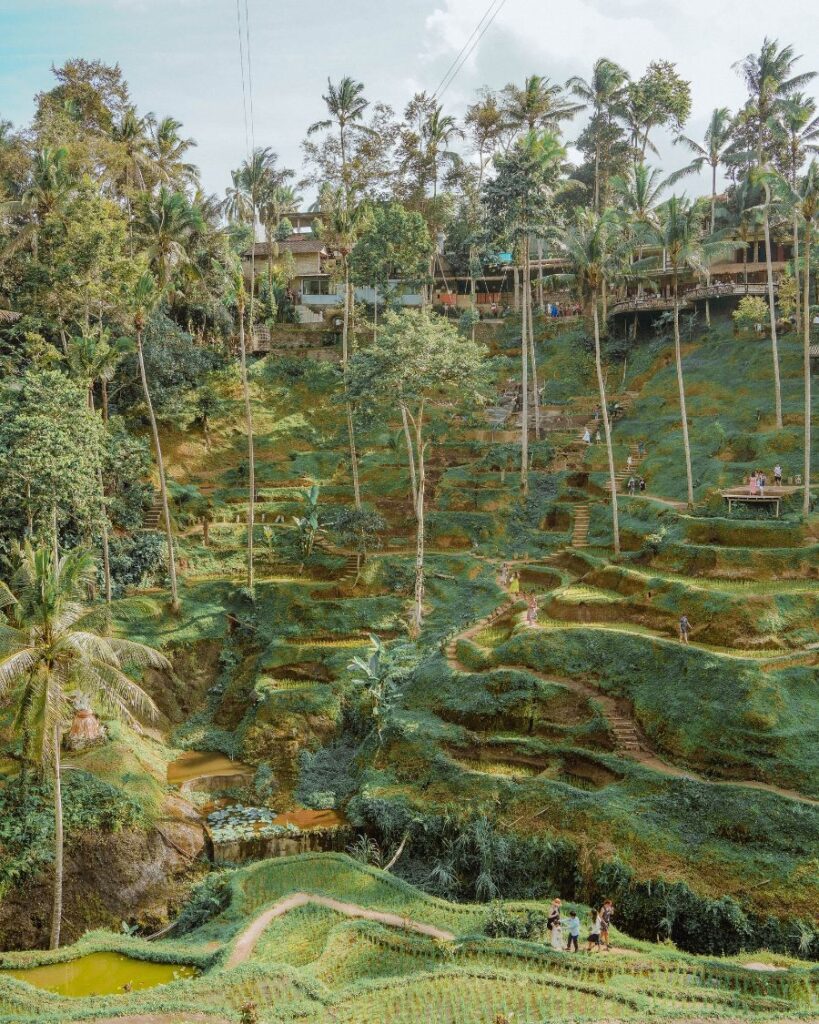
SIM Card and Data for Indonesia
There are two main options for getting a SIM card and data to use in Indonesia:
Option 1: eSIM with Airalo
The main advantages of purchasing an eSIM via Airalo (enter the referral code ROWAN1271 for a discount) are:
- you do not need to insert a physical SIM card, so you can keep your home country SIM in your phone
- you can get a multi-country eSIM rather than having to get a new one each time you go to a new country
- you can download the eSim before you leave your home country, meaning that you will have data immediately on arrival. This gives you peace of mind and is perfect for using Google Maps and rideshare apps etc.
- You can top up your data allowance via the app
Option 2: Buy a local physical SIM card
The main advantages of purchasing a local SIM card are:
- Local SIM cards generally offer better rates. You can often (depending on the country) get a lot more data for a lower price.
- You will get a local phone number which is better for making local calls / text messages
Personally I think Airalo is the best for short holidays or if you are only spending a short time in each country. If you’re staying for a longer time, or if like me you use a lot of data, a local physical SIM card may be better.
Get your Airalo eSIM here. Enter the referral code ROWAN1271 for a discount.
Travel Insurance
Make sure that you have travel insurance to cover you for your trip. I can highly recommend Heymondo. I use them to cover me for all my trips and their app is very easy to use.
Purchase Heymondo travel insurance here.

🌞 Useful Travel Resources & Essentials 🌞
By using the following links, you can support Call of the World at no additional cost to yourself
🏥 TRAVEL INSURANCE: Insure your trip with Heymondo, your trusted travel companion. They offer single-trip, annual and long-stay travel insurance. App with 24-hour medical support. (Call of the World readers get 5% off your travel insurance policy using my link)
🗺️ DAY TRIPS & CITY TOURS: Book your tours and activities with Viator. Viator partner with local guides and businesses to offer you the very best travel experiences available. Browse tours here.
💶 FOREIGN CURRENCY CARD: To pay by card and withdraw cash at the best rates, get a WISE card before your trip. This allows you to convert money into any other currency at the best rates and withdraw cash without hidden fees. WISE is a UK-based financial services company (available in most countries worldwide) and is highly regulated in the various regions it operates in (in the UK it is authorised by the Financial Conduct Authority).
📳 eSIM: Sort out an eSIM before your arrive with Airalo. Having an eSIM allows you to connect to local network data as soon as you arrive – super useful for Google Maps and rideshare apps!
🚂 BUS, TRAIN & FERRY TICKETS: Book your transportation in advance online using 12Go.
🚘 AIRPORT PICKUPS: Ensure peace of mind by booking your airport pickup with Welcome Pickups. Highly recommended if arriving late at night in an unfamiliar location.
🌿💫
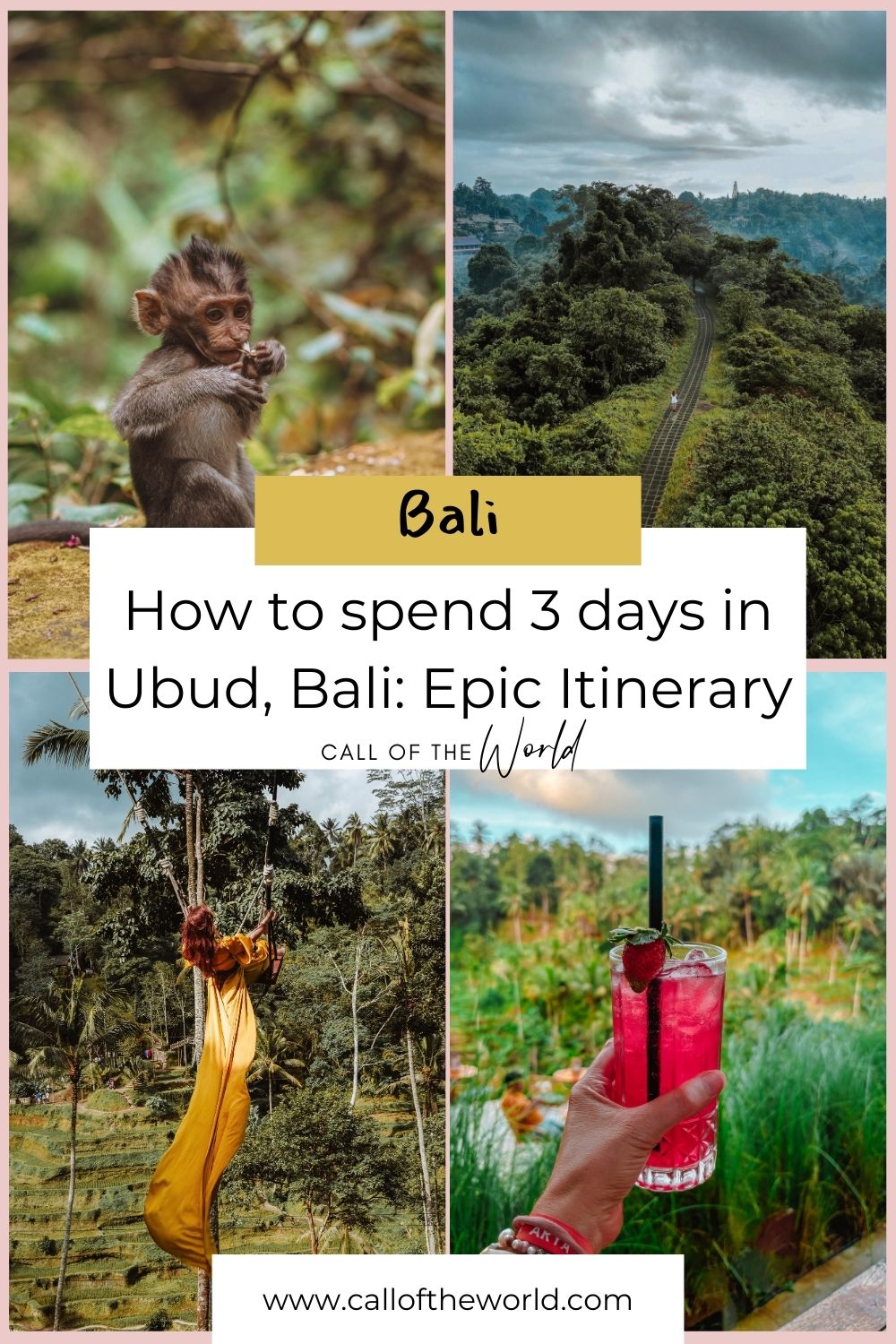


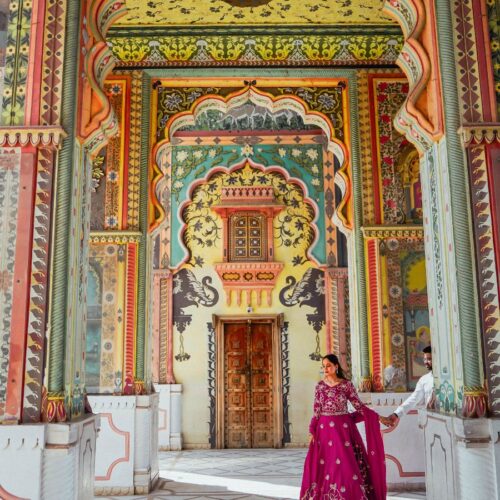


[…] Read: How to spend 3 days in Ubud, Bali […]